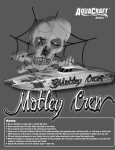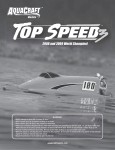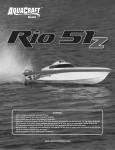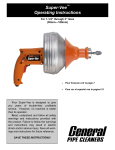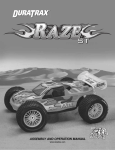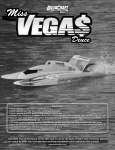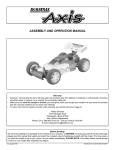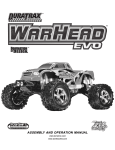Download AquaCraft SuperVee 27R Specifications
Transcript
ASSEMBLY AND OPERATION MANUAL ™ ™ ™ WARRANTY AquaCraft will warrant this kit for 90 days after the purchase from defects in materials or workmanship. AquaCraft will either repair or replace, at no charge, the incorrectly made part. Make sure you save the receipt or invoice you were given when you bought your model! It is your proof of purchase and we must see it before we can honor the warranty. To return your SuperVee 27 Nitro for repairs covered under warranty you should send your boat to: Hobby Services 3002 N. Apollo Drive, Suite 1 Champaign, Illinois 61822 Attn: Service Department Phone: (217) 398-0007, 9:00 am – 5:00 pm Central Time M-F E-mail: [email protected] Entire Contents © Copyright 2007 AQUZ1003 for AQUB22** V1.0 1. Under all circumstances return the ENTIRE system; boat and radio. TABLE OF CONTENTS 2. Make sure the transmitter is turned off, all batteries are removed and fuel is drained from the tank. SPECIFICATIONS & DESCRIPTION CHANGES ....................2 REPAIR SERVICE.........................................................................2 SAFETY PRECAUTIONS ............................................................2 USEFUL TOOLBOX ITEMS .......................................................3 OTHER USEFUL TOOLBOX ITEMS .........................................3 BOAT TERMINOLOGY..............................................................3 PREPARING YOUR BOAT FOR OPERATION ........................3 INSTALL THE RECEIVER ANTENNA ........................................4 INSTALL THE RECEIVER BATTERIES........................................4 CHECK THE RADIO SYSTEM ...................................................5 RUNNING THE ENGINE ..........................................................5 BREAKING IN THE ENGINE.....................................................5 RUNNING THE SUPERVEE 27 NITRO....................................6 TUNING THE SUPERVEE 27 NITRO .......................................6 MAINTENANCE .........................................................................7 RUNNING TIPS ..........................................................................9 RACING ......................................................................................9 NATIONAL MODEL BOATING ORGANIZATIONS ..............10 ENGINE TROUBLESHOOTING FLOWCHART ....................11 ORDERING REPLACEMENT PARTS ......................................11 AQUACRAFT .18 MARINE ENGINE EXPLODED VIEW...........................................Back Cover Page 3. Send written instructions which include: a list of all items returned, a THOROUGH explanation of the problem, the service needed and your phone number during the day. If you expect the repair to be covered under warranty, be sure to include a proof-of-purchase date (your store receipt or purchase invoice). 4. Be sure to send your full return address. SAFETY PRECAUTIONS • Adult supervision is strongly recommended! Children should be warned about the dangers of playing in close proximity to water. • Use care to avoid touching the propeller anytime the engine is running. Pay equally close attention to items such as loose clothing, shirt sleeves, ties, scarves, long hair or loose objects such as screwdrivers or pencils that may fall out of shirt or jacket pockets onto the spinning prop. If your fingers, hands, etc., come in contact with the spinning propeller, you may be severely injured. Thank you for purchasing the AquaCraft SuperVee 27™ Nitro. This manual contains the instructions you need to safely prepare, operate, and maintain your R/C boat. Read over this manual thoroughly before operating the SuperVee 27 Nitro boat. • Because of the speed and mass of this boat, it is capable of inflicting property damage and severe personal injury if a collision occurs. Never run this boat in the presence of swimmers or where the possibility of collision with people or property exists. If for any reason you feel this model is not for you, return it to your local dealer immediately. PLEASE NOTE: Your hobby dealer cannot accept a return on any model boat after assembly has begun. • Never threaten any wildlife or disturb fishermen with your model boat! This is the quickest way to get model boating banned from your favorite local pond. SPECIFICATION & DESCRIPTION CHANGES • Radio Control boats are controlled by radio signals, which are subject to possible interference from other R/C transmitters, paging systems or other electrical noise. Before turning your radio on, make sure no one else in the area is operating a radio on the same frequency (channel). All pictures, descriptions, and specifications found in this instruction manual are subject to change without notice. AquaCraft maintains no responsibility for inadvertent errors in this manual. • Model engine fuel is poisonous. Do not allow it to come into contact with the eyes or mouth. Always store fuel in a clearly marked container and out of the reach of children. REPAIR SERVICE • Model engine fuel is highly flammable. Keep it away from open flame, excessive heat, sources of sparks, or anything else that might ignite it. Do not smoke or allow anyone else to smoke in close proximity to open fuel. Make sure that fuel lines are in good condition so that fuel will not leak onto a hot engine causing a fire. Repair service is available anytime. After the 90-day warranty, you can still have your SuperVee 27 Nitro repaired for a small charge by the experts at AquaCraft’s authorized repair facility, Hobby Services, at the address listed on the front page of this manual. • Never operate your engine in an enclosed space. Model engines, like automobile engines, exhaust deadly carbon monoxide. Run your engine only in an open area. To speed up the repair process, please follow the proceeding instructions. 2 ❏ ❏ ❏ ❏ ❏ • Model engines generate considerable heat. Do not touch any part of your engine until it has cooled. Touching the muffler, cylinder head, or exhaust header may result in a serious burn. • Use safety glasses when starting or running engines. The propeller may throw loose material such as sand or gravel into your face. Cooler with plenty of cold water and soda Folding table Lawn chairs First-aid kit Canopy for shelter BOAT TERMINOLOGY • NEVER attempt to swim after a stalled or capsized boat. Wait patiently for the wind currents to return the boat to shore or use a tennis ball attached to the end of a fishing rod to retrieve a stalled or capsized boat. BOW: The front of the boat. STERN: The back of the boat. • NEVER operate your boat while standing in the water. PORT: This is the left side of the boat when aboard and facing the front (bow). • ALWAYS wear a personal flotation device when boarding and operating any retrieval craft. STARBOARD: This is the right side of the boat when aboard and facing the front (bow). If the buyer is not prepared to accept the liability associated with the use of this product, the buyer is advised to return this kit immediately in new and unused condition to the place of purchase. HULL: The body of the boat. DECK: The top of the boat. USEFUL TOOLBOX ITEMS HATCH: Typically a removable top to access the inside of the hull. As with any hobby, it is a good idea to assemble a useful collection of tools and accessories to bring along anytime you head out to the pond. Here are some items you will want to keep handy. ❏ ❏ ❏ ❏ ❏ ❏ ❏ ❏ ❏ ❏ ❏ ❏ PREPARING YOUR BOAT FOR OPERATION Carefully remove your SuperVee 27 Nitro boat and stand from the box. You may wish to keep the box in order to transport and store your SuperVee 27 Nitro. Metric and standard hex drivers 10mm Open end wrench 12mm Open end wrench Decals have been provided for your SuperVee 27 Nitro. Simply cut them out, peel, and stick! See the photos on the box for a decal placement example. Hobby knife (HCAR0109) Long nose pliers Glow plug wrench (DTXR1170) THE BOAT STAND Engine tuning screwdriver (DTXR1170) Spare glow plugs (DTXG3001) Fuel tubing (GPMQ4131) After Run™ engine oil (HCAP3000) Extra “AA” batteries AquaCraft GrimRacer™ Speed Grease cable lubricant (AQUB9500) OTHER USEFUL TOOLBOX ITEMS ❏ ❏ ❏ ❏ ❏ Your boat comes with a laser cut and engraved stand. It’s pre-built with soft protective cradle strips to help keep your boat scuff free. Paper towels Spray-on glass cleaner Sunglasses Sun block Waders or rubber boots 3 TRANSMITTER ASSEMBLY Note: The transmitter is not water resistant and should never come in contact with water. ❏ 2. Install the receiver antenna tube by pushing lightly into the plastic antenna base as shown. INSTALL THE RECEIVER BATTERIES ❏ 1. Remove the transmitter antenna from the plastic bag located on the back of the cardboard transmitter protector. Screw the antenna into the hole located at the top of the transmitter. Give a light tug on the antenna to make sure it is threaded in properly. ❏ 1. Open the radio box lid and install four fresh “AA” batteries in the battery holder. Be sure to follow the polarity configuration molded into the battery holder. ❏ 2. Slide the battery door open on the bottom of the transmitter and install eight (8) fresh “AA” batteries. Follow the diagram located in the bottom of the battery tray for proper battery orientation. ❏ 3. Turn the transmitter “ON”. The battery light should glow bright red. If the light does not turn on re-check the installation of the batteries. INSTALL THE RECEIVER ANTENNA ❏ 2. Plug the battery box connector into the ON/OFF switch connector. Do not force them together; they are designed to fit together only one way. ❏ 1. Locate and turn the rear hatch lock 1/4 turn to unlock and remove the hatch. ❏ 3. Replace the radio box lid and secure it with the latches located on both sides of the radio box. 4 ❏ 5. Secure the glow starter onto the engine’s glow plug. ❏ 4. Replace the hatch and secure it by pushing straight down on top of the rear hatch lock. ❏ 6. Check that the throttle is 1/8” open from the fully closed position. To adjust the idle speed, turn the idle stop screw in (clockwise) to increase the idle speed or out (counterclockwise) to slow the idle speed. Adjust the idle stop screw 1/8th of a turn at a time until the desired speed is reached. Pull the handle of the recoil starter in quick, short pulls. Repeat if necessary, until the engine fires. DO NOT PULL THE RECOIL HANDLE MORE THAN 381mm [15"]; DOING SO MAY DAMAGE THE PULL-START. CHECK THE RADIO SYSTEM • Standing behind the boat with both the receiver and transmitter powered up, rotate the wheel to the left. The back of the rudder should move towards the left. Move the wheel to the right. The back of the rudder should move towards the right. If this is not the case, simply move the transmitter steering servo reverse switch to the other position. ❏ 7. With the engine started, remove the glow starter after 10-15 seconds. • Squeeze the trigger on the transmitter; this should open the throat of the carburetor. Conversely, pushing the trigger should close the throat completely. ❏ 8. Put the hatch back in place and rotate the hatch lock at the rear of the boat to secure it in place. BE CAREFUL NOT TO TOUCH THE SPINNING PROP! RUNNING THE ENGINE If the engine fails to start, refer to the ENGINE TROUBLESHOOTING FLOWCHART on page 11. Before running the engine, read the manual completely. BREAKING IN THE ENGINE There are Several Simple Steps to Starting the Engine: IMPORTANT: The propeller will begin spinning as soon as the engine starts! Be certain that the propeller is unobstructed; failure to do so will damage the prop. To insure long life and good performance from your AquaCraft .18 engine, you MUST break-in the engine. The break-in period is critical for long life of the internal parts of the engine. This should be done over the first 5 tanks of fuel. ❏ 1. Install a glow plug if one is not in your engine. The glow plug threads into the top of the cylinder head. SOME THINGS TO REMEMBER DURING BREAK-IN ❏ 2. Fill the tank almost to the top. Leave a little air at the top of the tank. ❏ 1. Before running your SuperVee 27 Nitro it is a good idea to check the water cooling system to be sure all the lines are properly connected and in working condition. ❏ 3. Open the high-speed needle valve 2-1/2 turns out (counterclockwise) from fully closed. The high-speed needle is sticking up on the right side of the carburetor (looking at it from behind the boat). If you have previously run the boat, keep the same needle valve setting that you used on your last run. ❏ 2. Use the same fuel that you will use for normal running. Use nitro fuels that are specially formulated for model boat engines. Typically this would be 30-65% nitromethane boat fuel. ❏ 4. Prime the engine by placing a finger over the carburetor opening and pulling the starter handle 2-3 times or until you see fuel entering the carburetor. The quantity of fuel drawn into the engine by priming is an important factor in starting the engine successfully. ❏ 3. Resist the urge to accelerate and decelerate the boat quickly. ❏ 4. Break-in puts stress on the glow plug and you can burn it out. Make sure you have an extra plug or two on hand. 5 HOW TO STOP YOUR ENGINE DRIVING TIPS Just as squeezing the throttle trigger on your transmitter increases power, pushing the trigger the opposite way decreases power. Pushing the throttle trigger should close off the throat of the carburetor completely, cutting off air intake and stopping the engine. The motor and propeller spin counterclockwise on your SuperVee 27 Nitro. Torque from the engine and propeller naturally cause the boat to turn better to the right than to the left. Your SuperVee 27 Nitro is very fast and very agile. It’s a good idea to let off the throttle as you enter the corner. Likewise if the boat starts to get out of shape you will want to let off the throttle to get the boat settled back down. You can make adjustments to the boat’s hardware for better handling and even more performance, but just remember, one small adjustment at a time. For more tuning info see “TUNING YOUR SUPERVEE 27 NITRO” at the AquaCraft web site, www.aquacraftmodels.com or by reading below. THE FIRST TANK Your first tanks of fuel should be used to run the boat at a very rich high-speed needle valve setting. This allows the fuel to carry as much oil as possible into the engine to lubricate the internal parts during break-in. TANKS 1 TO 3 ❏ 1. Open the needle valve 2-1/2 turns out from fully closed (counterclockwise). This is factory set already, but check it to make sure. When closing the high-speed needle, close the needle until you feel some resistance. DO NOT overtighten or you will damage the carburetor. ❏ 2. Start the engine. ❏ 3. Once the engine is started, adjust the high-speed needle valve around 1/8th of a turn at a time, finding the setting where the engine just barely runs. This may take a few times. The engine will perform sluggishly and stall from time to time – this is normal during the break-in process. ❏ 4. Place the boat in water and run the engine at a medium speed, periodically accelerating and decelerating. ❏ 5. Continue running the engine until the tank is almost out of fuel. Do not allow the engine to run out of fuel. This leans out the engine and can cause overheating. TUNING YOUR SUPERVEE 27 NITRO PROPELLER CHOICES TANKS 4 & 5 The propeller plays a huge part in how your SuperVee 27 Nitro performs. The FRP (Fiber-Reinforced Plastic) prop that comes with the boat is a good all around prop but if you want even more performance, try your hand at a metal prop. To start with, here are a few good choices. Turn in the needle valve (clockwise) around 1/8th of a turn from the previous setting. You should notice that the engine performs better during each run. After the 5th tank, you should be near to the peak performance of the engine. RUNNING THE SUPERVEE 27 NITRO AquaCraft/GrimRacer 4053 (AQUA9715) AquaCraft/GrimRacer 4052/3 (AQUA9716) Octura X437/3, X438 Gently place the boat in water that is at least 8” deep and free of obstacles (weeds, rocks, sticks, ducks, muskrats, etc.). You can make hardware adjustments to your SuperVee 27 Nitro to suit your driving style or achieve maximum handling and speed for your water conditions. Throttle up to full speed. Note: Your SuperVee 27 Nitro may cavitate for the first 10 to 15 feet. This is normal! If the boat has a tendency to turn right or left, adjust the steering trim knob on your transmitter until the boat runs in a straight line when the steering wheel is at neutral. Strut Settings: You can use the information below as a guideline to help you understand what happens when you adjust the angle of the strut. Remember that the prop and water conditions play a huge part in the performance of the boat. When you are ready to bring your boat back to shore, drive it parallel to the shoreline. After you have stopped the motor, turn the boat towards the shore. 6 trim plates (negative). If it looks like the boat is running wet, you can bend the trim plates up a small amount (positive). MAINTENANCE RADIO BOX MAINTENANCE Positive Angle: Positive strut angle causes the bow (front) to run high, making the boat faster but less stable and likely to blow off course or crash in rough water. This also places the least amount of stress on the motor and speed control. When finished running, remove the hatch, open the radio box by unsnapping the side latches and unplug the receiver battery. Let the cover sit on the side of the boat and wipe away water that might have collected in the radio box compartment. It is best to leave the radio box cover and hatch cover off the boat overnight to allow any water that might enter to evaporate. Neutral or No Angle: Good for most setups, but ultimately the prop, weight of the boat and water conditions will determine if you are going to run your boat with Neutral strut angle. ENGINE MAINTENANCE Negative Angle: Negative strut angle can cause the boat to run tight. Remember, make small adjustments at a time as negative strut angle places the most amount of stress on the drive components. Too much negative angle and your boat might “stuff” dive under water if it comes off a wave. Remember, small adjustments are best. • Drain any remaining fuel from the tank. • Remove the glow plug. • Place a few drops of Hobbico® After Run Oil (HCAP3000) into the carburetor and in the cylinder head. Place a rag over the cylinder head and gently pull the recoil starter a few times to spread the oil throughout the engine. HULL MAINTENANCE • Remove the hatch cover. • Open the radio box. • Soak up any excess water with a paper towel. • Wipe down the entire boat with spray-on glass cleaner and a soft cotton towel. Rudder Angle: Tilting the bottom of the rudder to a positive angle (away from the transom) will cause the transom to run higher out of the water in the corners. Tucking it under will cause the transom to run deeper. Keep in mind as you make your adjustments that a small change can make a big difference. DRIVESHAFT MAINTENANCE ❏ 1. Remove the hatch cover. ❏ 2. Use the 12mm wrench to hold the flywheel nut in Trim Plates: The trim plates are used to help control the ride of the hull. If the boat is hopping, you can bend down the place while loosening the collet assembly with the 10mm wrench as shown. 7 keeping it clean and not over-leaning the engine. • Make sure that you use a fuel from a reputable manufacturer that is labeled as model boat engine fuel. • Avoid using old fuels in the engine. After running for the day, run all of the fuel out of the engine. Use after run oil (HCAP3000) and work it into the engine by pulling the pull-starter 2-3 times. • Do not use silicone sealer on the engine joints. Silicone sealer contains acetic acid, which is corrosive if it gets inside your engine. ❏ 3. Gently pull the driveshaft out and wipe off any old grease. • Store your engine someplace where it will not be subjected to extreme temperature changes. If you are having problems with your engine, consult the “ENGINE TROUBLESHOOTING FLOWCHART” on page 11 of this manual. The following are some potential problems. GLOW PLUG The glow plug is an item that will wear out and need replacement from time to time. It is a good idea to remove the glow plug before your first run, attach it to the glow starter and see how well it glows. You should see a bright orange glow from the filament. If a coil or two will not glow or the plug will not glow at all, replace the plug. If the engine quits when you remove the glow starter, the plug might need to be changed, although this may be because you are running too rich and need to screw in your high-speed needle some. Look at the glow plug when you are running the engine. If you see any bubbles coming from around the plug, replace the glow plug (copper) gasket, or both the plug and the gasket. The only real way to test a glow plug is to replace it. Make sure you have a spare plug or two on hand every time that you run the SuperVee 27 Nitro. ❏ 4. Apply AquaCraft GrimRacer Speed Grease cable lubricant (AQUB9500) or heavy-duty marine grade cable grease to the driveshaft and reinsert it into the stuffing box. Slowly rotate the driveshaft while gently pushing it back into place. Be sure to leave about a 3mm [1/8"] gap minimum between the drive dog and the stuffing box as shown. FUEL Fuel can go bad. The main ingredient in model fuel is methanol, which is basically a form of alcohol. Alcohols absorb water out of the air, so keep your fuel jug cap on at all times. Store your fuel out of the sunlight and in a cool place. Bad fuel is one of the most difficult problems to diagnose in engines. If you have tried everything you can think of to remedy an engine that is not running correctly, try using some fresh fuel. ❏ 5. Use the 12mm wrench to hold the flywheel steady while tightening the collet assembly with the 10mm wrench as shown. Make sure there is still a 3mm [1/8"] gap between the drive dog and the stuffing box. FUEL LINE WAYS TO ENSURE LONG ENGINE LIFE. Fuel line is susceptible to pinhole leaks. You will not be able to see a hole in the fuel line, but if you see bubbles in the line going to the carburetor, replace the fuel line. Another symptom of a leak in the fuel line is a surging engine. A properly tuned engine will surge when the air bubbles enter the carburetor. It is basically leaning out the mixture. • Keep your engine clean. Dirt will act as insulation on an engine. It will not be able to shed heat as easily. • Do not over-lean your engine. • Do not run your engine at high speeds with the boat out of the water. • Do not overheat the engine. This goes along with 8 OVERHEATING RACING One of the worst things you can do to your engine is overheat it. The oils that lubricate the engine are carried in the fuel. If your engine is set too lean, there will not be enough oil in the engine to lubricate the internal parts. This will cause premature wear in the engine and cause damage. Although it is very enjoyable to go out and run the SuperVee 27 Nitro by yourself, the real fun and excitement of R/C boating is experienced when you get involved in racing. Racing against other boats is much different than running your boat alone. The following suggestions will provide helpful strategies when racing a model boat. RUNNING TIPS A good set-up for running alone may not be the best for racing conditions. Race water conditions create challenges different from running alone. Five or six boats racing against one another will create rough water conditions on the race course and to successfully compete in racing situations, it may be necessary to “tighten” the ride characteristics. PLEASE READ these valuable tips as well as the “SAFETY PRECAUTIONS” at the beginning of this manual BEFORE running the SuperVee 27 Nitro to ensure a successful and safe run. If your SuperVee 27 should happen to stall or capsize, water currents and wind will slowly carry it to shore. The bad news is that the boat could be carried to the opposite shore. Keep variables like wind direction, currents, and the size of the lake in mind when surveying areas to run your boat. Wakes caused by other boats can upset the balance and ride characteristics of even a well trimmed model boat. When running down the straight-aways, don’t follow in another boat’s wake. Wakes generated by other boats while entering and negotiating a corner are especially dangerous. A helpful tip is to use a fishing reel with at least a 12lb. line with a tennis ball tied to the end to retrieve stalled boats. It is not advisable to run R/C boats on any free-flowing body of water such as creeks or rivers. Racing other boats through a corner presents possibly the greatest challenge. The first corner after the start of a race can be especially challenging. The boat entering the corner first has the task of holding its position (often called “holding your lane”) through the corner and following boats must then attempt to hold their lanes. Changing lanes and crossing a wake to gain position in a turn can have disastrous results. Executing a good start in the inside lane is one key to successful racing. If for whatever reason your boat takes on a large amount of water, swamps or sinks causing the radio equipment to get wet, you must do the following immediately: • Remove the radio equipment from the boat. Allow ALL the components to air dry completely. Reinstall the components and check for proper operation before running the boat again. Avoid beating yourself. In any type of racing, there are some situations you can control and other situations that you cannot control. The ability to set the needle-valve on the engine so it runs the entire race without stopping, checking the linkages, fasteners, fuel tubing, amount of fuel, glow plug, and radio system are conditions/situations that can be dealt with prior to the start of a race. During the race, making a good start and driving defensively are controllable actions. By focusing on tasks and actions that can be controlled, successful racing outcomes can be achieved. If the engine quits from ingesting water it may be difficult to restart. To make the engine easier to restart, do the following as soon as the boat has been recovered: • Remove the glow plug from the engine and set it aside to dry. • Drain the fuel tank of any remaining fuel to eliminate the possibility of water contaminated fuel. • Place a rag over the open glow plug hole and pull on the recoil handle as many times as needed to flush the water and remaining fuel out of the engine. Note: The recoil will get easier to pull as fluid exits the engine. • Test the glow plug for proper operation by attaching the glow starter. You should see a bright orange glow from the filament. Reinstall or replace the glow plug as need. With these steps completed, re-start the engine as outlined in the “RUNNING THE ENGINE” section. 9 NATIONAL MODEL BOATING ORGANIZATIONS There are three national model boating organizations in the United States and Canada: APBA or American Power Boat Association (RC Boat Category) www.apba-rcboating.com • For “drag racing” place the buoys similar to the above sketch. IMPBA or International Model Power Boat Association www.impba.net NAMBA or North American Model Boat Association www.namba.com Each of the three organizations has its own rule book governing model boat racing, sanctioned events, and recognized records. Organized model boat racing is offered at both regional and national levels. Location of clubs, race dates and locations, membership applications, and other information can be obtained through their respective web sites. • For “oval racing” place the buoys similar to the above sketch. Note: The patterns shown are not based on any sort of official standards; therefore, you may set up racecourses any way you choose. Smaller courses provide more action and excitement. Another good source for information regarding all aspects of model boat operation is: The length of the races can be determined by a set number of laps around the buoys (for example, the first boat to complete five (5) laps is the winner); or by time (for example, whoever is leading at the end of two (2) minutes is the winner). http://www.rcuniverse.com GOOD LUCK AND GREAT BOATING! Of course, racing does not have to be an organized and sanctioned competition to be fun. Small informal races can be very exciting. Here are some suggestions for setting up a simple racecourse for boats: • Make 2 to 4 simple and inexpensive “marker buoys” with empty milk jugs, string, and heavy objects for anchors, similar to the above sketch. 10 ENGINE TROUBLESHOOTING FLOWCHART ORDERING REPLACEMENT PARTS To order replacement parts for the AquaCraft SuperVee 27 Nitro, use the order numbers in the Replacement Parts List that follows. Replacement parts are available only as listed and can be purchased from hobby shops or mail order/ Internet order firms. Hardware items (screws, nuts, bolts) are also available from these outlets. If you need assistance locating a dealer to purchase parts, visit www.hobbico.com and click on “Where to buy.” If this kit is missing parts, contact Hobbico Product Support. REPLACEMENT PARTS LIST Order # AQUB9213 AQUB6503 AQUB8604 AQUB7891 AQUB7890 AQUB9522 AQUZ1003 AQUB9521 AQUB9520 AQUB6902 AQUB6903 AQUB6904 AQUB6316 AQUB6317 AQUB6318 AQUB6319 AQUB6320 AQUB6321 AQUB6322 AQUB6701 AQUB7892 AQUB9009 AQUB7889 Order # AQUB6201 AQUB9044 AQUB7885 AQUB7882 AQUB7100 AQUB7883 AQUB7884 AQUB7881 AQUB8713 AQUG1147 AQUG6000 AQUG6001 AQUG6002 Description Header Cooling Coil ISO .18 Engine Mount Radio Box w/ Tray FRP 3-Blade 37mm Prop (2) Rudder Blade FE Mono Port Turn Fin Instruction Manual Rubber Switch Boot and Plate Transom Water Pick Up Assembly Fuel Tank Green Fuel Tubing 3' Blue Water Tubing 3' Decal Sheet – White Decal Sheet – Blue Decal Sheet – Red Decal Sheet – Yellow Decal Sheet – Green Decal Sheet – Orange GrimRacer Decal Sheet Engine Flywheel Engine Cable Coupler Linkage and Connector Set Rudder Bracket 11 Description White Fiberglass Cowl Trim Plates w/ Backplates Drive Dog w/ Prop Nut FE Mono Turn Fin Boat Stand, Unassembled Drive Cable w/Prop Shaft Prop Shaft Strut Bushing FE Mono Strut Assembly Rudder Control Arm .18 Marine Engine .18 Exhaust Header w/Coupler .18 Tuned Pipe Silicone Exhaust Extension AQUACRAFT .18 INBOARD MARINE ENGINE EXPLODED VIEW ENGINE PARTS LIST AQUG1147 AquaCraft .18 Marine Engine Stock # AQUG4101 AQUG4151 AQUG4201 AQUG4223 AQUG4226 AQUG4241 AQUG4261 AQUG4351 AQUG4411 AQUG4501 AQUG4551 AQUG4601 AQUG4651 AQUG4652 AQUG4739 AQUG4751 AQUG4771 AQUG4772 AQUG5041 AQUG5042 AQUG5241 Description Front Bearing Rear Bearing Carb Complete Carb Gasket (O-ring) Throttle Arm Nut Carb Retainer Screws Carb Barrel (Rotor) Connecting Rod Backplate w/Gasket Crankcase Crankshaft Piston/Sleeve Set Water Cooling Head Head Button Carb Dust Cover Fuel Inlet Backplate Gasket Head Gasket Idle Needle w/O-ring Idle Needle O-ring Piston Pin Includes 12 x 1pc 10 x 1pc 35 x 1pc 7 x 1pc 24 x 1pc 36 x 2pcs 27 x 1pc 6 x 1pc 8, 16 x 1pc 11 x 1pc 9 x 1pc 3, 4 x 1pc 1, 13 x 1pc 13 x 1pc 26 x 1pc 31 x 1pc 8 x 1pc 2 x 1pc 22, 23 x 1pc 23 x 1pc 5 x 1pc Stock # AQUG5511 AQUG5512 AQUG5226 AQUG5527 AQUG5528 AQUG5529 AQUG5621 AQUG5622 AQUG5721 AQUG5831 AQUG5871 AQUG6000 AQUG6001 AQUG6002 AQUG9213 Description Includes Recoil Start Assembly 18 x 1pc One-Way Bearing 37 x 1pc Needle Socket 32 x 1pc Needle Valve w/O-ring 33 x 1pc Needle Valve Assembly 31, 32, 33, 34 x 1pc Needle Valve O-ring 33 x 1pc Backplate Screws 17 x 4pcs Head Screws 20 x 4pcs Start Shaft 15 x 1pc Throttle Arm 25 x 1pc Throttle Stop Screw Assembly 29, 30 x 1pc Exhaust Header w/Coupler 42, 43, 44 x 1pc, 40, 41, 45 x 2pcs .18 Tuned Pipe 46, 47, 48 x 1pc Tuned Pipe Silicone Extension 49 x 1pc Header Cooling Coil 50 x 1pc














